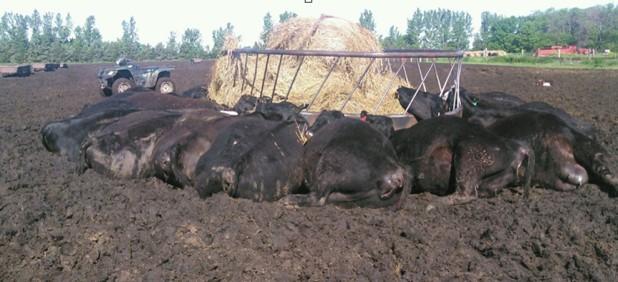
2 minute read
4.3 Thunderstorm / Lightning Strikes
Thunderstorms are a common weather event in Alberta. These storms are often accompanied by lightning strikes, heavy rains, strong winds, and hail. Livestock are killed by lightning strikes every year, and it is not uncommon for multiple animals huddled together to be killed by one strike. High winds that may accompany storms can also impact livestock in the vicinity.
Thunderstorms can be extremely dangerous when they occur during an outdoor livestock event (i.e., 4-H show, jumping event, rodeo). Animals will react, and may act up or try to flee during a storm injuring handlers and spectators.
Entities Impacted
• All animals in storm area. • Moderate to catastrophic impact on animal health and welfare may include pain and suffering, loss of housing/containment, risk of injury, loss of feed and water sources.
Response
• Identify CFO’s or livestock events in the path of the thunderstorm. • Issue thunderstorm alert to affected areas. • Livestock sense weather changes and it can impact their behaviour. Be aware animal behaviour may change before, during, and even after a storm. • Be alert at all times of loose livestock. These animals will be frightened and may charge or attack first responders or other people in the area. Utilize low stress, safe livestock handling practices (see Section 3.1
General Livestock Handling). • Assess building structures. Survey damage to barns and other structures; assess the stability and safety. Be on the lookout for building damage, and frightened animals. • Examine animals closely. Common injuries may include impalements and lacerations from flying debris or burns from lightning strikes. Request veterinary care if required. • Animals that require euthanasia must be euthanized as soon as it can be safely done. Animals cannot be transported for euthanasia, and must be euthanized where they are located. • Ensure access to euthanasia tools and personnel to euthanize animals are available within the impact area and at temporary housing area (see Section 3.8 Euthanasia). • If determined that temporary housing is required, implement the Housing and Containment aspect of this plan (Section 3.2 Housing and Containment). • Dead stock will need to be disposed of as soon as possible to prevent disease spread, public health, and environmental issues. Producers may need assistance if animals exceed the 2,500 kg limitation or they do not have access to a burial site. • Dead stock disposal method and means to be identified if mass animal casualty. • Dead stock to be removed to designated disposal site or temporary holding area (see Section 3.9 Dead Stock). • Temporary housing may need to be identified if structural damage prevents animals from being housed in their existing facilities.




